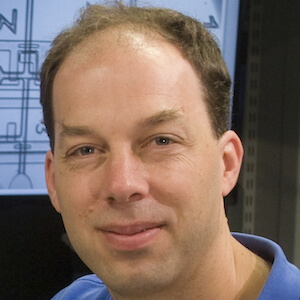Biography
Steve Quake has pioneered innovative approaches to biological measurement, including the invention of microfluidic large-scale integration, the biological equivalent of the integrated circuit, which has enabled large-scale automation of biology. He has developed applications of microfluidics in areas as diverse as structural biology, drug discovery, and molecular affinity measurements. Equally innovative in the field of genomics, Quake generated the first single-molecule human genome sequence, developed techniques to perform single cell gene expression and genome sequencing, non-invasive prenatal diagnostics, prenatal genome sequencing, non-invasive tests for heart transplant rejection, and approaches to sequence the immune system. He was also one of the first people in the world to see their own genome. Quake joined the faculty of the California Institute of Technology at age 26 and returned to Stanford University in 2005 to help launch the department of Bioengineering after having earned his B.S. in Physics and M.S. in Mathematics there in 1991. He has founded or co-founded 7 companies including Fluidigm, Helicos Biosciences, Verinata Health, and Immumetrix. Quake is an Investigator of the Howard Hughes Medical Institute, has been elected to the National Academy of Sciences, the National Academy of Engineering, the Institute of Medicine, among other institutions and is the recipient of numerous awards including the NIH Director’s Pioneer Award. He earned his D.Phil. in Physics from Oxford University in 1994 as a Marshall Scholar and conducted postdoctoral work at Stanford in single molecules biophysics.
Session Abstract – PMWC 2020 Silicon Valley
Researchers have long been recognizing the uniqueness of women’s health and the substantial effect on clinical practice, acknowledging the increasing appreciation of the importance of multidisciplinary approaches to health and disease. In every organ system, there are diseases that are unique to women, more common in women than in men, or characterized by differences in disease course in women compared with men. This session will include the effect of women’s health on the following topics:
- Reproductive Women's Health Overview
- Michelle Strecker, Invitae - Preterm Birth & The Promise Of Biomarkers
New “omics” assays that measure multiple biomarkers shed light on processes that lead to increased risk of preterm birth and generate biomarkers of risk of preterm birth that are useful for prediction. Those two applications (mechanism identification and prediction) could be useful for developing therapeutic targets, diagnostic tests, as well as identifying populations at particularly high risk in whom interventions might be most important.
- Amy Murtha, UCSF
- Laura Jelliffe-Pawlowski, UCSF
- Stephen Quake, Stanford - Preterm Birth and Oral Health
- Michael Reddy, UCSF - NIPT
Current non-invasive prenatal screening is targeted toward the detection of chromosomal abnormalities in the fetus, providing much higher test sensitivity and specificity than traditional maternal serum screening for trisomy 21, 18 and 13. New approaches for non-invasive prenatal sequencing are being developed to detect causative genes for frequent dominant monogentic diseases that can lead to significant adverse health outcomes. This will help guide physician and parent decisions for further evaluation and management of the pregnancy.
- Brynn Levy, Columbia University - The Evolution Of Genetic Carrier Screening
Before definitive identification of causative genes and associated mutations, carrier screening relied on biochemical techniques, utilizing measurements of enzyme activity and/or substrate levels. As genes and mutations were identified, molecular-based screening became the standard. Advances in molecular technologies, especially next-generation sequencing (NGS), have changed the landscape of carrier screening – providing information about multiple genes, the whole exome, or even the whole genome. The panel will discuss the conditions and genes most appropriate for screening, and whether it is time to screen the whole genome.
- Jennifer Saucier, Natera - Infertility Outcomes: Genetics And Epigenetics
This talk will cover the impact of genetics and epigenetics of infertility diagnosis associated with epigenetics of various treatments on overall pregnancy outcomes. Studies are starting to suggest that genetics and epigenetics of infertility diagnoses affect outcomes for mother and child, which may be a greater contributor than treatments utilized.
- Margareta D. Pisarska, Cedars-Sinai Medical Center - AI in IVF: Selection Of Optimal Embryo
AI is not meant to replace the doctors and embryologists but rather to be used as a tool to medical practitioners in augmenting correct diagnoses and increase the robustness of the treatments and increase pregnancy and LB rates.
- Nikica Zaninovic, Weill Cornell Medical College - Expanded Carrier Screening For Serious Inherited Disorders
Carrier screening has been a routine part of prenatal care for over 50 years. Traditionally, screening has been limited to a small number of conditions in selected ethnic groups. This talk will describe advances in technology that now make possible pan-ethnic screening for a large number of serious conditions.
- James Goldberg, Myriad - Precision Medicine Leads to Better Fertility Outcomes
- Aimee Eyvazzadeh, Egg Whisperer - Endometriosis
This common, estrogen-dependent, inflammatory disease that is associated with a high prevalence of pelvic pain and reduced fertility in women remains challenging for clinicians, researchers, and those affected. A considerable heritable component to endometriosis risk has been established through both family- and population-based studies. New minimally invasive diagnostic methods are being developed to enable early intervention that might reduce suffering and expenses related to the disease.
- Heather Bowerman, Dotlab - Preimplantation Genetic Testing Beyond Recessive Disease
- Alex Bisignano, Phosphorus - In Vitro Fertilization
Despite continual advances in techniques and technology since the introduction of in vitro fertilization more than 40 years ago, this approach is successful in fewer than half of initiated cycles. Major advancements have been made in methods to improve oocyte quality in older women, new stimulation protocols that may improve the number of mature oocytes retrieved during in vitro fertilization cycle, pre-implantation genetic screening, and endometrial receptivity evaluation.
- Akash Kumar, MyOme Inc.
- Claire Tomkins, Future Family - Menopause and Early Predictors
Current osteoporosis medications reduce fractures significantly but have rare and serious adverse effects that may limit their safety for long-term use. Insights from basic bone biology and genetic disorders have led to recent advances in therapeutics for osteoporosis. Combination and sequential treatments using osteoporosis medications with different mechanisms of action have also been tested with promising results. On the horizon is the potential for cell-based therapies and drugs that target the elimination of senescent cells in the bone microenvironment.
- Marcelle Cedars, UCSF - Breast Cancer Genetics: Molecular Tumor Signatures and Hereditary Cancer Tests
Advances in molecular pathology and hereditary cancer assays have led to a new understanding of breast cancer classification systems, allowing for precision thera-py using molecular tumor signatures that guide both systemic treatments and per-sonalized radiotherapy. The goal is to minimize overtreatment and treatment-associated morbidity for patients while preventing progression and recurrence. This session will focus on the current state of progress in these pursuits and discuss the challenges including prior authorization issues and the growing size of assay pan-els.
- Ramesh Hariharan, Natera
- Eleanor Harris, Case Western
- George Sledge, Stanford
- Barbara Cohn, Public Health Institute









